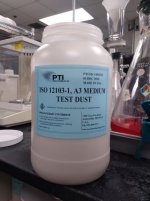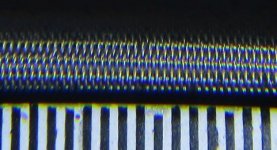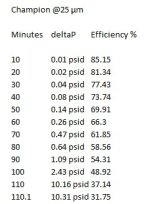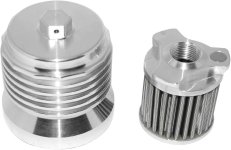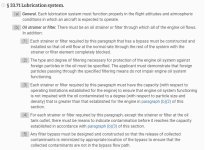The results are in.
Previous organizational thread here: https://vansairforce.net/threads/oil-filter-testing.223689/
Please support and thank our many individual donors, and our two vendor sponsors, Barrett Precision Engines and CamGuard.
There are many interesting details, and research continues. More in due course, but for now, a short synopsis...
The world standard for comparative filter test is ISO 4548-12. The 4548-12 test installation circulates a standard fluid (MIL-H-5606, here Aeroshell 4) at 100F and 6 gallons per minute while steadily feeding ISO 12103-1 test dust into the flow. A laser-based device counts particles while determining the size of each particle. The fluid then enters the filter. Downstream, another counter records the number and size of the particles which passed through the filter. For each particle size from 4 through 40 µm (microns), efficiency ratio = 1- (particles out/particles in).
As the test progresses, the filter accumulates particles, and the differential pressure measured across the element slowly rises. The rise begins slowly, but as the filter nears capacity, the rate of rise steepens significantly. The test is terminated at some specified deltaP, here being 10 psi. The total capacity of the filter is recorded in grams.
The tested filters were a Tempest 48108, a Champion 48108, a Wix 51515 (aka a NAPA 1515), a K&P S-15, and a Challenger.
Average efficiencies from inception to 10 psi deltaP, contaminent retained, and time to termination:
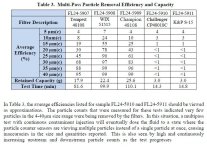
ISO 12103-1 medium test dust particle size distribution. Although the filter may capture all or none of the sizes, the 4548-12 test system is calibrated for counting the shaded range:
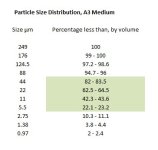
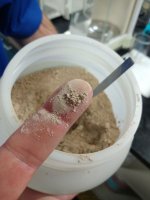
What is good enough?
The agreed standard for piston aviation oil filters is SAE ARP 1400- Rev B. The standard covers all aspects of filter construction and performance (example, burst pressure), but the key point here is filtration efficiency at two particle sizes. ARP 1400-B specifies the SAE J1858 multipass proceedure for measuring filtration, essentially identical to ISO-4548-12. The minimum required performance is >75% at 25 µm, and >90% at 40 µm, with 15 grams retention, and a terminal deltaP of 8 psi. Neither Tempest or Champion appears to meet the 25 µm requirement.
The viscosity of 50W AD aviation oil at 180F (+ or - 5) is roughly 32 cSt, vs 15 cSt for the MIL-H-5606 fluid used for ISO 4548-12 and J1658 tests. As a general rule, higher viscosity would be expected to reduce capture efficiency.
In general, we want particle size to be less than oil film thickness. For now, two textbook illustrations. The first is from Heywood's Internal Combustion Engine Fundamentals:
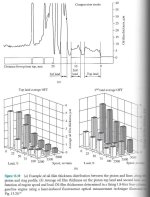
And this from John Schwaner's Sky Ranch Engineering Manual:
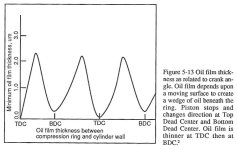
Previous organizational thread here: https://vansairforce.net/threads/oil-filter-testing.223689/
Please support and thank our many individual donors, and our two vendor sponsors, Barrett Precision Engines and CamGuard.
There are many interesting details, and research continues. More in due course, but for now, a short synopsis...
The world standard for comparative filter test is ISO 4548-12. The 4548-12 test installation circulates a standard fluid (MIL-H-5606, here Aeroshell 4) at 100F and 6 gallons per minute while steadily feeding ISO 12103-1 test dust into the flow. A laser-based device counts particles while determining the size of each particle. The fluid then enters the filter. Downstream, another counter records the number and size of the particles which passed through the filter. For each particle size from 4 through 40 µm (microns), efficiency ratio = 1- (particles out/particles in).
As the test progresses, the filter accumulates particles, and the differential pressure measured across the element slowly rises. The rise begins slowly, but as the filter nears capacity, the rate of rise steepens significantly. The test is terminated at some specified deltaP, here being 10 psi. The total capacity of the filter is recorded in grams.
The tested filters were a Tempest 48108, a Champion 48108, a Wix 51515 (aka a NAPA 1515), a K&P S-15, and a Challenger.
Average efficiencies from inception to 10 psi deltaP, contaminent retained, and time to termination:

ISO 12103-1 medium test dust particle size distribution. Although the filter may capture all or none of the sizes, the 4548-12 test system is calibrated for counting the shaded range:


What is good enough?
The agreed standard for piston aviation oil filters is SAE ARP 1400- Rev B. The standard covers all aspects of filter construction and performance (example, burst pressure), but the key point here is filtration efficiency at two particle sizes. ARP 1400-B specifies the SAE J1858 multipass proceedure for measuring filtration, essentially identical to ISO-4548-12. The minimum required performance is >75% at 25 µm, and >90% at 40 µm, with 15 grams retention, and a terminal deltaP of 8 psi. Neither Tempest or Champion appears to meet the 25 µm requirement.
The viscosity of 50W AD aviation oil at 180F (+ or - 5) is roughly 32 cSt, vs 15 cSt for the MIL-H-5606 fluid used for ISO 4548-12 and J1658 tests. As a general rule, higher viscosity would be expected to reduce capture efficiency.
In general, we want particle size to be less than oil film thickness. For now, two textbook illustrations. The first is from Heywood's Internal Combustion Engine Fundamentals:

And this from John Schwaner's Sky Ranch Engineering Manual:

Last edited:



